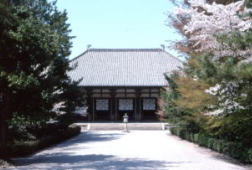TOP > Welcome to Rekishikaido > Nishinokyo(Nara city)
Main route Nishinokyo(Nara city)
 Nishinokyo (literally meaning the “western palace”) gets its name from being to the right or west of the Heijo-kyo Palace in today’s western suburbs of Nara City.
Nishinokyo (literally meaning the “western palace”) gets its name from being to the right or west of the Heijo-kyo Palace in today’s western suburbs of Nara City.
It refers to the area on the west bank of the Akishino River and encompasses sights such as Yakushi-ji Temple, Toshodai-ji Temple, the Tomb of the Emperor Suinin, Kiko-ji Temple, Sugawara-jinja Shrine and Saidai-ji Temple. Also, the kilns of Akahada-yaki ceramics were found in the foothills.
Point1
The section from Aska to Kyoto via Nara is the features of Rekishikaido that you can do “time travel” from early days to modern age explore the history.
You can take railroads, the JR line and the Kintetsu line.
Kintetsu limited express is useful for sightseeing. The train runs from Kyoto station to Nara or Kashihara station every 15 minutes.
JR line connections have been improving in recent years.
The JR Sakurai line the railway along with mountain path, has a flavor as a local line.
Point2
Nara has many sightseeing spots besides those we showed. “Gankoittetsu”in Nishinokyo in the institution for improving. The owner of a charcoal-manufacturing factory established this institution. We can buy goods and see how to make charcoal.

|
Yakushi-ji Temple(World Heritage)
The Emperor Tenmu built Yakushi-ji Temple in Kiyomuhara, Asuka (now Asuka Village, Nara Prefecture) to pray for his wife's (Empress Jito) recovery from illness.
When the capital was relocated to Nara, the temple was moved to its current site. The two pagodas that professor and Oriental scholar Ernest Fenollosa described as "chilling music," referring to their subtle rhythmic appearance (they differ in height), are stunning structures that retain their original appearance from when they were built.
How to get there: Approx. 3 min on foot from Nishinokyo Station on the Kintetsu Kashihara Line
Open: 8:30 - 17:00
Admission fee: 500yen
Kiko-ji Temple
This old temple is also known as Sugawara-dera. The current structure of the main hall (Important Cultural Property) was rebuilt on top of the original foundation in the Muromachi Period.
Legend has it that the Monk Gyoki built it as a prototype to the Daibutsu-den Hall of Todai-ji Temple, at one-tenth the size. For this reason, it is also called the "Kokoromi no Daibutsuden", literally meaning an "assay of the Daibutsuden".
TEL: 0742-45-4630
Open: 9:00 - 16:30
Admission: Adults \300

|
Toshodai-ji Temple(World Heritage)
Toshodai-ji Temple Built by Wajo Ganjin, this temple exhibits the representative architecture of the Tempyo Period. The grounds have several magnificent buildings that are registered as National Treasures such as the main hall, which is famous for recounts in the historically inspired short story "Tempyo no Iraka" (iraka refers to the top ridge and tiles of roofs) by 20th century writer Yasushi Inoue, oratory, drum tower and library of scriptures.
How to get there: Approx. 10 min on foot from Nishinokyo Station on the Kintetsu Kashihara Line
Open: 8:30 - 17:00
Admission fee: 600yen










